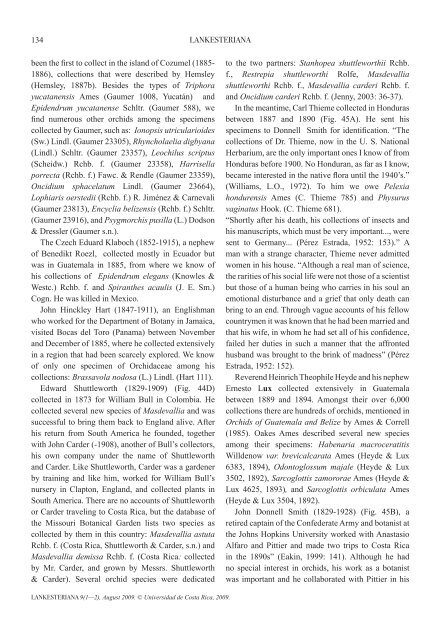orchids and orchidology in central america. 500 ... - lankesteriana.org
orchids and orchidology in central america. 500 ... - lankesteriana.org
orchids and orchidology in central america. 500 ... - lankesteriana.org
You also want an ePaper? Increase the reach of your titles
YUMPU automatically turns print PDFs into web optimized ePapers that Google loves.
134<br />
been the first to collect <strong>in</strong> the isl<strong>and</strong> of Cozumel (1885-<br />
1886), collections that were described by Hemsley<br />
(Hemsley, 1887b). Besides the types of Triphora<br />
yucatanensis Ames (Gaumer 1008, Yucatán) <strong>and</strong><br />
Epidendrum yucatanense Schltr. (Gaumer 588), we<br />
f<strong>in</strong>d numerous other <strong>orchids</strong> among the specimens<br />
collected by Gaumer, such as: Ionopsis utricularioides<br />
(Sw.) L<strong>in</strong>dl. (Gaumer 23305), Rhyncholaelia digbyana<br />
(L<strong>in</strong>dl.) Schltr. (Gaumer 23357), Leochilus scriptus<br />
(Scheidw.) Rchb. f. (Gaumer 23358), Harrisella<br />
porrecta (Rchb. f.) Fawc. & Rendle (Gaumer 23359),<br />
Oncidium sphacelatum L<strong>in</strong>dl. (Gaumer 23664),<br />
Lophiaris oerstedii (Rchb. f.) R. Jiménez & Carnevali<br />
(Gaumer 23813), Encyclia belizensis (Rchb. f.) Schltr.<br />
(Gaumer 23916), <strong>and</strong> Psygmorchis pusilla (L.) Dodson<br />
& Dressler (Gaumer s.n.).<br />
The Czech Eduard Klaboch (1852-1915), a nephew<br />
of Benedikt Roezl, collected mostly <strong>in</strong> Ecuador but<br />
was <strong>in</strong> Guatemala <strong>in</strong> 1885, from where we know of<br />
his collections of Epidendrum elegans (Knowles &<br />
Westc.) Rchb. f. <strong>and</strong> Spiranthes acaulis (J. E. Sm.)<br />
Cogn. He was killed <strong>in</strong> Mexico.<br />
John H<strong>in</strong>ckley Hart (1847-1911), an Englishman<br />
who worked for the Department of Botany <strong>in</strong> Jamaica,<br />
visited Bocas del Toro (Panama) between November<br />
<strong>and</strong> December of 1885, where he collected extensively<br />
<strong>in</strong> a region that had been scarcely explored. We know<br />
of only one specimen of Orchidaceae among his<br />
collections: Brassavola nodosa (L.) L<strong>in</strong>dl. (Hart 111).<br />
Edward Shuttleworth (1829-1909) (Fig. 44D)<br />
collected <strong>in</strong> 1873 for William Bull <strong>in</strong> Colombia. He<br />
collected several new species of Masdevallia <strong>and</strong> was<br />
successful to br<strong>in</strong>g them back to Engl<strong>and</strong> alive. After<br />
his return from South America he founded, together<br />
with John Carder (-1908), another of Bull’s collectors,<br />
his own company under the name of Shuttleworth<br />
<strong>and</strong> Carder. Like Shuttleworth, Carder was a gardener<br />
by tra<strong>in</strong><strong>in</strong>g <strong>and</strong> like him, worked for William Bull’s<br />
nursery <strong>in</strong> Clapton, Engl<strong>and</strong>, <strong>and</strong> collected plants <strong>in</strong><br />
South America. There are no accounts of Shuttleworth<br />
or Carder travel<strong>in</strong>g to Costa Rica, but the database of<br />
the Missouri Botanical Garden lists two species as<br />
collected by them <strong>in</strong> this country: Masdevallia astuta<br />
Rchb. f. (Costa Rica, Shuttleworth & Carder, s.n.) <strong>and</strong><br />
Masdevallia demissa Rchb. f. (Costa Rica: collected<br />
by Mr. Carder, <strong>and</strong> grown by Messrs. Shuttleworth<br />
& Carder). Several orchid species were dedicated<br />
LANKESTERIANA<br />
LANKESTERIANA 9(1—2), August 2009. © Universidad de Costa Rica, 2009.<br />
to the two partners: Stanhopea shuttleworthii Rchb.<br />
f., Restrepia shuttleworthi Rolfe, Masdevallia<br />
shuttleworthi Rchb. f., Masdevallia carderi Rchb. f.<br />
<strong>and</strong> Oncidium carderi Rchb. f. (Jenny, 2003: 36-37).<br />
In the meantime, Carl Thieme collected <strong>in</strong> Honduras<br />
between 1887 <strong>and</strong> 1890 (Fig. 45A). He sent his<br />
specimens to Donnell Smith for identification. “The<br />
collections of Dr. Thieme, now <strong>in</strong> the U. S. National<br />
Herbarium, are the only important ones I know of from<br />
Honduras before 1900. No Honduran, as far as I know,<br />
became <strong>in</strong>terested <strong>in</strong> the native flora until the 1940’s.”<br />
(Williams, L.O., 1972). To him we owe Pelexia<br />
hondurensis Ames (C. Thieme 785) <strong>and</strong> Physurus<br />
vag<strong>in</strong>atus Hook. (C. Thieme 681).<br />
“Shortly after his death, his collections of <strong>in</strong>sects <strong>and</strong><br />
his manuscripts, which must be very important..., were<br />
sent to Germany... (Pérez Estrada, 1952: 153).” A<br />
man with a strange character, Thieme never admitted<br />
women <strong>in</strong> his house. “Although a real man of science,<br />
the rarities of his social life were not those of a scientist<br />
but those of a human be<strong>in</strong>g who carries <strong>in</strong> his soul an<br />
emotional disturbance <strong>and</strong> a grief that only death can<br />
br<strong>in</strong>g to an end. Through vague accounts of his fellow<br />
countrymen it was known that he had been married <strong>and</strong><br />
that his wife, <strong>in</strong> whom he had set all of his confidence,<br />
failed her duties <strong>in</strong> such a manner that the affronted<br />
husb<strong>and</strong> was brought to the br<strong>in</strong>k of madness” (Pérez<br />
Estrada, 1952: 152).<br />
Reverend He<strong>in</strong>rich Theophile Heyde <strong>and</strong> his nephew<br />
Ernesto Lux collected extensively <strong>in</strong> Guatemala<br />
between 1889 <strong>and</strong> 1894. Amongst their over 6,000<br />
collections there are hundreds of <strong>orchids</strong>, mentioned <strong>in</strong><br />
Orchids of Guatemala <strong>and</strong> Belize by Ames & Correll<br />
(1985). Oakes Ames described several new species<br />
among their specimens: Habenaria macroceratitis<br />
Willdenow var. brevicalcarata Ames (Heyde & Lux<br />
6383, 1894), Odontoglossum majale (Heyde & Lux<br />
3502, 1892), Sarcoglottis zamororae Ames (Heyde &<br />
Lux 4625, 1893), <strong>and</strong> Sarcoglottis orbiculata Ames<br />
(Heyde & Lux 3504, 1892).<br />
John Donnell Smith (1829-1928) (Fig. 45B), a<br />
retired capta<strong>in</strong> of the Confederate Army <strong>and</strong> botanist at<br />
the Johns Hopk<strong>in</strong>s University worked with Anastasio<br />
Alfaro <strong>and</strong> Pittier <strong>and</strong> made two trips to Costa Rica<br />
<strong>in</strong> the 1890s” (Eak<strong>in</strong>, 1999: 141). Although he had<br />
no special <strong>in</strong>terest <strong>in</strong> <strong>orchids</strong>, his work as a botanist<br />
was important <strong>and</strong> he collaborated with Pittier <strong>in</strong> his
















